
|
It brightened up to 6.2 mag in June (June 24, Marco Goiato). Now it is fading. It has already faded down to 11.4 mag (Aug. 26, Thomas Lehmann). It it not observable already in the Northern Hemisphere. In the Southern Hemisphere, it will be getting lower after this, and will be unobservable in October.
Date(TT) R.A. (2000) Decl. Delta r Elong. m1 Best Time(A, h)
Sept. 3 14 19.19 -28 17.5 2.606 2.313 62 10.7 19:06 ( 82, 44)
Sept.10 14 21.03 -28 3.0 2.803 2.387 55 11.0 19:11 ( 79, 37)
|
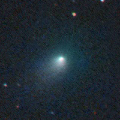
|
Now it is 12.6 mag (Aug. 20, Thomas Lehmann). It will be fading gradually after this. In the Northern Hemisphere, it keeps low for a long time after this.. In the Southern Hemisphere, it keeps observable in good condition for a long time.
Date(TT) R.A. (2000) Decl. Delta r Elong. m1 Best Time(A, h)
Sept. 3 15 7.50 -20 58.3 1.609 1.573 69 12.0 19:06 ( 99, 51)
Sept.10 15 27.99 -22 52.4 1.664 1.588 67 12.1 19:11 ( 95, 49)
|
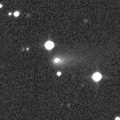
|
Now it is 11.3 mag (Sept. 1, Sandor Szabo). It is observable at 12 mag from summer to autumn, but it keeps low for some time.
Date(TT) R.A. (2000) Decl. Delta r Elong. m1 Best Time(A, h)
Sept. 3 8 6.86 15 54.3 1.969 1.368 40 12.1 4:52 (243, 9)
Sept.10 8 28.85 13 38.7 1.959 1.379 41 12.1 4:42 (246, 10)
|
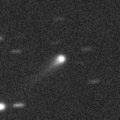
|
It brightened rapidly up to 13.4 mag (Aug. 31, Sandor Szabo). It will be observable at 12-13 mag until autumn.
Date(TT) R.A. (2000) Decl. Delta r Elong. m1 Best Time(A, h)
Sept. 3 14 59.21 -14 57.2 2.195 2.009 66 12.4 19:06 (105, 46)
Sept.10 15 13.92 -15 22.8 2.251 2.001 62 12.4 19:11 (101, 42)
|

|
Now it is 11.1 mag (July 31, Chris Wyatt). It is not observable now in the Northern Hemisphere. It will be unobservable soon also in the Southern Hemisphere.
Date(TT) R.A. (2000) Decl. Delta r Elong. m1 Best Time(A, h)
Sept. 3 12 32.60 -1 20.4 2.482 1.653 27 12.5 19:06 ( 94, 8)
Sept.10 12 51.41 -3 17.5 2.522 1.673 25 12.6 19:11 ( 90, 7)
|

|
It brightened up to 8-9 mag from winter to spring. Now it is fading. It has already faded down to 12.9 mag (July 23, Chris Wyatt). It is not observable now. It will appear in the morning sky at 14 mag in November in the Northern Hemisphere, or in December in the Southern Hemisphere.
Date(TT) R.A. (2000) Decl. Delta r Elong. m1 Best Time(A, h)
Sept. 3 12 6.95 7 41.4 4.574 3.637 19 13.0 19:06 ( 98, -2)
Sept.10 12 12.56 6 14.5 4.661 3.695 14 13.1 19:11 ( 93, -7)
|

|
Now it is 13.5 mag (Aug. 30, Jakub Cerny). It is observable in excellent condition in the Southern Hemisphere.
Date(TT) R.A. (2000) Decl. Delta r Elong. m1 Best Time(A, h)
Sept. 3 19 15.72 -25 30.7 5.254 5.907 126 13.4 20:24 (180, 80)
Sept.10 19 14.94 -25 23.7 5.346 5.905 119 13.4 19:56 (180, 80)
|

|
It keeps unobservable for a long time. It will appear in the morning sky in December, when the comet will be fainter than 15 mag.
Date(TT) R.A. (2000) Decl. Delta r Elong. m1 Best Time(A, h)
Sept. 3 10 18.75 3 39.1 2.406 1.416 8 13.4 4:52 (272,-10)
Sept.10 10 42.02 1 33.3 2.414 1.426 8 13.5 4:42 (275,-10)
|
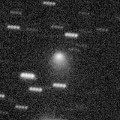
|
Now it is so bright as 11.6 mag (Aug. 29, Juan Jose Gonzalez). It is observable in excellent condition in the Northern Hemispehre. It will be observable in good condition after this also in the Southern Hemisphere.
Date(TT) R.A. (2000) Decl. Delta r Elong. m1 Best Time(A, h)
Sept. 3 20 49.56 29 26.8 1.041 1.882 133 13.5 21:54 (180, 26)
Sept.10 20 10.16 20 34.8 1.089 1.885 128 13.6 20:48 (180, 35)
|
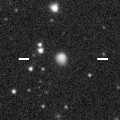
|
Now it is 13.9 mag (Aug. 30, Jakub Cerny). It is expected to brighten up to 7 mag in 2017 summer. In the Northern Hemisphere, it becomes low temporarily in summer, but it keeps observable in good condition until the highlight while the comet will be brightening. In the Southern Hemisphere, it is not observable until early 2017.
Date(TT) R.A. (2000) Decl. Delta r Elong. m1 Best Time(A, h)
Sept. 3 10 18.64 50 27.8 4.446 3.777 43 13.7 4:52 (228,-32)
Sept.10 10 32.46 49 56.5 4.341 3.711 45 13.6 4:42 (228,-31)
|

|
Now it is 13.7 mag (Aug. 27, Sandor Szabo). It will be fading gradually after this. In the Northern Hemisphere, it keeps observable until early November. It becomes observable in the evening sky from July to September also in the Southern Hemisphere.
Date(TT) R.A. (2000) Decl. Delta r Elong. m1 Best Time(A, h)
Sept. 3 15 21.59 24 12.8 3.490 3.233 67 13.8 19:06 (142, 20)
Sept.10 15 26.03 21 31.8 3.603 3.273 63 14.0 19:11 (135, 19)
|
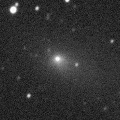
|
Now it is 13.6 mag (Aug. 26, Alexander Baransky). Distant object, but it keeps observable at 14 mag for a long time from 2015 to 2016.
Date(TT) R.A. (2000) Decl. Delta r Elong. m1 Best Time(A, h)
Sept. 3 0 50.84 -0 3.9 4.047 4.936 148 14.0 2:02 (180, 55)
Sept.10 0 49.46 -0 38.2 4.008 4.944 155 14.0 1:33 (180, 56)
|
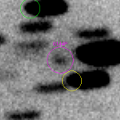
|
It became so bright as 8 mag in 2009. It was expected to brighten up to 11-12 mag from summer to autumn. But actually, it is 13.9 mag (Sept. 2, Kunihiro Shima), fainter than originally expected by 3 mag. It keeps locating low for a while.
Date(TT) R.A. (2000) Decl. Delta r Elong. m1 Best Time(A, h)
Sept. 3 8 35.16 16 55.3 2.154 1.432 33 14.1 4:52 (247, 3)
Sept.10 8 57.83 15 13.2 2.140 1.436 34 14.0 4:42 (249, 3)
|
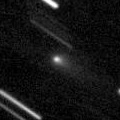
|
Now it is bright as 13.9 mag (Sept. 1, Sandor Szabo). It had been lost for a long time over 200 years since its discovery in 1783. The condition of this apparition is excellent, and it will brighten up to 14 mag in autumn. In the Northern Hemisphere, it is observable in excellent condition from summer to winter. In the Southern Hemisphere, it keeps observable in good condition until November.
Date(TT) R.A. (2000) Decl. Delta r Elong. m1 Best Time(A, h)
Sept. 3 5 1.96 6 45.6 1.537 1.776 85 14.2 4:52 (208, 44)
Sept.10 5 10.32 9 7.3 1.462 1.777 90 14.1 4:42 (204, 43)
|
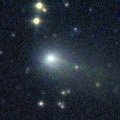
|
It brightened up to 12.5 mag in summer (Aug. 3, Marco Goiato). Now it is fading. It has already faded down to 14.0 mag (Sept. 1, Seiichi Yoshida). It keeps observable in good condition for a while.
Date(TT) R.A. (2000) Decl. Delta r Elong. m1 Best Time(A, h)
Sept. 3 20 52.06 -16 17.3 1.709 2.633 150 14.1 22:00 (180, 71)
Sept.10 20 51.37 -16 42.9 1.779 2.655 143 14.3 21:32 (180, 72)
|
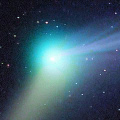
|
It brightened up to 6 mag from autumn to winter. Now it is fading. It has already faded down to 13.9 mag (Aug. 31, Jakub Cerny). It is observable in good condition in the Northern Hemisphere. It is not observable after this in the Southern Hemisphere.
Date(TT) R.A. (2000) Decl. Delta r Elong. m1 Best Time(A, h)
Sept. 3 6 4.86 51 30.6 4.373 4.178 72 14.4 4:52 (201, -2)
Sept.10 6 3.17 52 14.1 4.336 4.252 78 14.5 4:42 (198, -1)
|

|
It has brightened in outburst up to 14 mag twice, in 2006 January and 2011 May. Third outburst occured on Aug. 28, and now it is bright as 14.8 mag (Aug. 30, Juan Jose Gonzalez). It is observable in good condition in autumn.
Date(TT) R.A. (2000) Decl. Delta r Elong. m1 Best Time(A, h)
Sept. 3 1 26.25 6 57.4 5.494 6.282 138 15.0 2:37 (180, 48)
Sept.10 1 24.75 6 44.3 5.439 6.294 145 15.0 2:08 (180, 48)
|
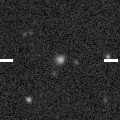
|
Now it is 16.4 mag (Aug. 12, Thomas Lehmann). It will be unobservable temporarily from summer to autumn. Then it will appear in the morning sky at 13 mag in December. It is expected to brighten up to 7 mag in 2017 spring. But it locates somewhat low at the high light.
Date(TT) R.A. (2000) Decl. Delta r Elong. m1 Best Time(A, h)
Sept. 3 12 3.73 -4 25.4 4.506 3.592 22 15.3 19:06 ( 87, 4)
Sept.10 12 11.14 -5 7.7 4.464 3.516 17 15.2 19:11 ( 83, -1)
|

|
Appearing in the morning sky in the Northern Hemisphere. It keeps unobservable until October in the Southern Hemisphere.
Date(TT) R.A. (2000) Decl. Delta r Elong. m1 Best Time(A, h)
Sept. 3 9 16.13 13 9.8 2.961 2.074 23 15.4 4:52 (256, -2)
Sept.10 9 31.43 12 11.1 2.945 2.091 26 15.6 4:42 (256, -1)
|
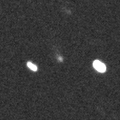
|
Now it is bright as 14.9 mag (May 4, Hidetaka Sato). It keeps 15 mag until autumn. In the Southern Hemisphere, it keeps observable for a long time. It will be unobservable after this in the Northern Hemisphere.
Date(TT) R.A. (2000) Decl. Delta r Elong. m1 Best Time(A, h)
Sept. 3 11 37.10 -58 13.4 2.668 2.447 66 15.5 19:06 ( 36, 27)
Sept.10 12 10.65 -57 51.6 2.748 2.475 63 15.6 19:11 ( 36, 27)
|
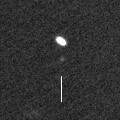
|
It is appearing in the morning sky in the Northern Hemisphere. It is expected to brighten up to 14 mag from winter to spring in 2017, and it will be observable in excellent condition in the Northern Hemisphere. In the Southern Hemisphere, it keeps extremely low until autumn, and it will be low also around the higlight.
Date(TT) R.A. (2000) Decl. Delta r Elong. m1 Best Time(A, h)
Sept. 3 8 20.38 28 15.9 3.212 2.534 40 15.8 4:52 (236, -1)
Sept.10 8 35.16 28 1.0 3.140 2.518 44 15.7 4:42 (236, -1)
|

|
It brightened up to 13.0 mag in spring (May 6, Marco Goiato). It is already unobservable in the Northern Hemisphere. In the Southern Hemisphere, it keeps observable in good condition until autumn. But it will be fading slowly after this.
Date(TT) R.A. (2000) Decl. Delta r Elong. m1 Best Time(A, h)
Sept. 3 14 12.47 -31 5.0 2.756 2.453 62 15.9 19:06 ( 78, 44)
Sept.10 14 25.31 -32 9.2 2.836 2.467 58 16.1 19:11 ( 75, 40)
|
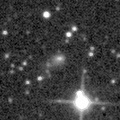
|
Now it is 16.2 mag (Aug. 31, Sandor Szabo). It will be observable at 13 mag for a long time from 2017 to 2018. In 2016, it keeps observable at 16 mag in good condition until autumn.
Date(TT) R.A. (2000) Decl. Delta r Elong. m1 Best Time(A, h)
Sept. 3 18 46.45 -9 29.1 5.296 5.868 120 16.1 19:55 (180, 64)
Sept.10 18 42.25 -9 22.1 5.364 5.825 112 16.1 19:23 (180, 64)
|
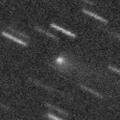
|
Now it is 16.1 mag (Aug. 8, Hiroshi Abe). It became brighter than originally predicted. But it will be fading after this. In the Southern Hemisphere, it keeps observable until winter, but it locates somewhat low. In the Northern Hemisphere, it is observable in excellent condition.
Date(TT) R.A. (2000) Decl. Delta r Elong. m1 Best Time(A, h)
Sept. 3 6 2.93 23 54.1 1.645 1.609 70 16.2 4:52 (215, 22)
Sept.10 6 18.42 25 26.5 1.622 1.646 73 16.5 4:42 (214, 21)
|
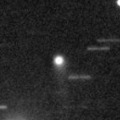
|
Now it is 15.3 mag (Sept. 1, Sandor Szabo). It will brighten up to 14 mag from summer to winter in 2017. Then it will be observable in excellent condition in the Northern Hemisphere. In the Southern Hemisphere, it is hardly observable around the highlight.
Date(TT) R.A. (2000) Decl. Delta r Elong. m1 Best Time(A, h)
Sept. 3 23 58.99 -17 53.0 3.777 4.737 160 16.3 1:11 (180, 73)
Sept.10 23 51.80 -17 44.1 3.716 4.693 164 16.3 0:36 (180, 73)
|
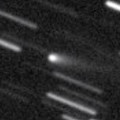
|
Now it is 15.0 mag (Sept. 1, Sandor Szabo). It will be observable at 15-16 mag in good condition from autumn to winter. It locates somewhat low in the Southern Hemisphere.
Date(TT) R.A. (2000) Decl. Delta r Elong. m1 Best Time(A, h)
Sept. 3 4 17.59 29 12.1 2.272 2.534 93 16.3 4:52 (189, 25)
Sept.10 4 25.14 29 57.0 2.198 2.542 98 16.3 4:42 (186, 25)
|
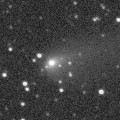
|
It was observed at 13 mag for a long time from winter to early summer. Now it is fading. It has already faded down to 16.8 mag (Aug. 16, CAO, San Pedro de Atacama). It is observable in excellent condition in the Southern Hemisphere. But it locates somewhat low in the Northern Hemisphere.
Date(TT) R.A. (2000) Decl. Delta r Elong. m1 Best Time(A, h)
Sept. 3 16 8.42 -24 25.6 2.608 2.697 84 16.4 19:06 (107, 64)
Sept.10 16 17.75 -24 44.5 2.720 2.722 79 16.5 19:11 (101, 60)
|
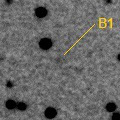
|
Now it is 16.2 mag (June 29, iTelescope Observatory, Siding Spring). It keeps 16 mag for a long time until 2017. It is already unobservable in the Northern Hemisphere. It will be unobservable in October also in the Southern Hemisphere.
Date(TT) R.A. (2000) Decl. Delta r Elong. m1 Best Time(A, h)
Sept. 3 13 38.06 -19 37.1 3.888 3.326 49 16.4 19:06 ( 87, 32)
Sept.10 13 47.96 -19 15.3 3.944 3.309 44 16.4 19:11 ( 84, 27)
|

|
It has been lost since its discovery in 1978. In 2016, it is expected to return in excellent condition from autumn to winter.
Date(TT) R.A. (2000) Decl. Delta r Elong. m1 Best Time(A, h)
Sept. 3 19 30.28 -32 39.6 0.678 1.521 127 16.7 20:39 (180, 88)
Sept.10 19 33.01 -32 28.2 0.678 1.480 121 16.4 20:14 (180, 87)
|

|
Now it is 15.7 mag (Aug. 25, Alexander Baransky). It keeps 16.5 mag from 2016 to 2017. It is observable in good condition in the Northern Hemisphere. In the Southern Hemisphere, it locates low in 2016, and it is not observable in 2017.
Date(TT) R.A. (2000) Decl. Delta r Elong. m1 Best Time(A, h)
Sept. 3 16 32.27 34 16.7 6.335 6.281 82 16.8 19:06 (162, 18)
Sept.10 16 33.56 33 57.8 6.392 6.276 78 16.8 19:11 (155, 16)
|
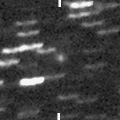
|
Now it is 16.6 mag (Aug. 4, A. Diepvens). It keeps 16-17 mag and keeps observable in good condition until autumn.
Date(TT) R.A. (2000) Decl. Delta r Elong. m1 Best Time(A, h)
Sept. 3 17 41.51 -11 42.7 2.170 2.610 104 16.8 19:06 (170, 66)
Sept.10 17 46.34 -11 57.2 2.238 2.592 98 16.8 19:11 (154, 65)
|
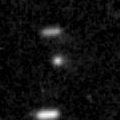
|
Now it is 16.5 mag (Aug. 25, Alexander Baransky). It will brighten up to 15 mag in winter. But it will be getting lower gradually after autumn.
Date(TT) R.A. (2000) Decl. Delta r Elong. m1 Best Time(A, h)
Sept. 3 22 23.91 -11 13.1 1.428 2.433 172 17.0 23:31 (180, 66)
Sept.10 22 16.75 -11 8.3 1.404 2.389 164 16.8 22:56 (180, 66)
|
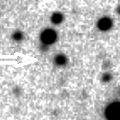
|
Now it is 16.3 mag (Aug. 31, Kunihiro Shima). It will brighten up to 13 mag and will be observable in good condition in 2017 summer. In 2016, it keeps observable until winter when it will brighten up to 15.5 mag. It locates somewhat low in the Southern Hemisphere.
Date(TT) R.A. (2000) Decl. Delta r Elong. m1 Best Time(A, h)
Sept. 3 3 28.26 31 16.8 4.141 4.476 102 17.1 4:39 (180, 24)
Sept.10 3 22.07 31 29.1 3.968 4.426 110 17.0 4:06 (180, 23)
|
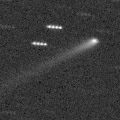
|
It brightened up to 15 mag from late 2014 to early 2016. Now it is fading slowly. Now it is 16.1 mag (Aug. 16, D. Buczynski). In the Northern Hemisphere, it will be observable at 16-17 mag in autumn in good condition. It locates extremely low in the Southern Hemisphere.
Date(TT) R.A. (2000) Decl. Delta r Elong. m1 Best Time(A, h)
Sept. 3 22 45.57 44 23.7 4.461 5.144 128 17.0 23:52 (180, 11)
Sept.10 22 33.11 44 5.9 4.470 5.177 130 17.0 23:12 (180, 11)
|
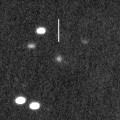
|
Now it is 18.5 mag (Aug. 11, CAO, San Pedro de Atacama). It will be observable at 16 mag in good condition from autumn to winter. It locates low in the Southern Hemisphere.
Date(TT) R.A. (2000) Decl. Delta r Elong. m1 Best Time(A, h)
Sept. 3 6 50.28 24 9.3 4.335 3.917 59 17.0 4:52 (224, 16)
Sept.10 6 57.15 24 7.9 4.235 3.908 64 17.0 4:42 (222, 17)
|
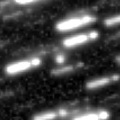
|
Now it is 16.9 mag (July 30, Yasukazu Ikari). It will brighten up to 16 mag and will be observable in good condition in 2017. In 2016, it is observable in excellent condition in the Southern Hemisphere, but it keeps low in the Northern Hemisphere.
Date(TT) R.A. (2000) Decl. Delta r Elong. m1 Best Time(A, h)
Sept. 3 18 37.22 -37 23.4 2.645 3.218 116 17.1 19:46 ( 0, 88)
Sept.10 18 38.92 -36 45.4 2.715 3.201 109 17.1 19:20 ( 0, 88)
|
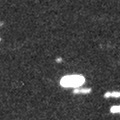
|
Now it is 17.5 mag (Aug. 4, Toshiyuki Takahashi). It will brighten up to 15 mag and will be observable in good condition from autum to winter in 2017. In the Northern Hemisphere, it keeps observable in good condition for a long time while the comet will be brightening. It is not observable until 2017 summer in the Southern Hemisphere.
Date(TT) R.A. (2000) Decl. Delta r Elong. m1 Best Time(A, h)
Sept. 3 5 16.76 57 20.6 5.811 5.721 79 17.4 4:52 (193, -5)
Sept.10 5 13.75 57 48.0 5.668 5.685 85 17.3 4:42 (190, -4)
|
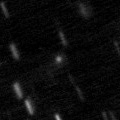
|
Now it is 18.0 mag (July 24, CAO, San Pedro de Atacama). It keeps 17 mag for a long time in 2016, and it will be observable in excellent condition in the Southern Hemisphere. It is hardly observable in the Northern Hemisphere.
Date(TT) R.A. (2000) Decl. Delta r Elong. m1 Best Time(A, h)
Sept. 3 2 45.11 -49 18.2 2.995 3.549 115 17.3 3:56 ( 0, 76)
Sept.10 2 27.69 -50 32.4 2.970 3.570 119 17.3 3:12 ( 0, 75)
|
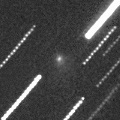
|
Now it is 17.9 mag (Aug. 8, J. Gonzalez). It keeps 17-18 mag until autumn. It keeps observable in excellent condition in the Northern Hemisphere. It will be getting lower gradually in the Southern Hemisphere.
Date(TT) R.A. (2000) Decl. Delta r Elong. m1 Best Time(A, h)
Sept. 3 19 36.85 37 44.2 1.737 2.365 116 17.4 20:43 (180, 17)
Sept.10 19 18.29 37 32.0 1.834 2.386 110 17.6 19:58 (180, 17)
|

|
It brightened up to 13-14 mag from 2014 to 2015. Now it is fading. It has already faded down to 17.0 mag (Aug. 12, iTelescope Observatory, Siding Spring). It will be fainter than 18 mag in October.
Date(TT) R.A. (2000) Decl. Delta r Elong. m1 Best Time(A, h)
Sept. 3 23 13.76 -5 21.8 4.686 5.689 173 17.5 0:25 (180, 60)
Sept.10 23 11.02 -5 47.7 4.727 5.734 178 17.5 23:51 (180, 61)
|
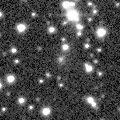
|
It will pass the perihelion in 2019. However, it has not been brightening since the discovery in 2010. Now it is 18.1 mag (Aug. 10, D. Buczynski). It keeps observable in excellent condition in the Northern Hemisphere. It is not observable in the Southern Hemisphere.
Date(TT) R.A. (2000) Decl. Delta r Elong. m1 Best Time(A, h)
Sept. 3 4 42.34 55 58.7 10.007 9.964 84 17.5 4:52 (189, -2)
Sept.10 4 43.45 56 35.2 9.890 9.943 90 17.5 4:42 (186, -2)
|

|
Now it is 19.4 mag (Sept. 1, K. Sarneczky, P. Szekely). It was expected to brighten up to 16.5 mag and will be observable in good condition from autumn to winter. But actually, it is fainter than predicted by 1.5 mag.
Date(TT) R.A. (2000) Decl. Delta r Elong. m1 Best Time(A, h)
Sept. 3 3 31.25 -9 35.2 2.053 2.582 110 17.7 4:42 (180, 65)
Sept.10 3 35.93 -10 9.0 1.962 2.556 114 17.5 4:19 (180, 65)
|
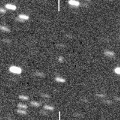
|
First return of a new periodic comet discovered in 2008. Now it is 18.8 mag (Aug. 1, M. Jaeger, E. Prosperi, S. Prosperi, W. Vollmann). It keeps observable at 17.5 mag until autumn.
Date(TT) R.A. (2000) Decl. Delta r Elong. m1 Best Time(A, h)
Sept. 3 20 4.52 -19 22.3 2.260 3.089 138 17.6 21:13 (180, 74)
Sept.10 20 3.54 -19 22.9 2.324 3.084 131 17.6 20:44 (180, 74)
|

|
Now it is 17.9 mag (Aug. 25, Alexander Baransky). It will be observable at 17.5 mag in good condition in autumn.
Date(TT) R.A. (2000) Decl. Delta r Elong. m1 Best Time(A, h)
Sept. 3 23 9.72 4 26.2 1.608 2.601 166 17.7 0:21 (180, 50)
Sept.10 23 5.64 4 6.4 1.575 2.574 170 17.6 23:45 (180, 51)
|
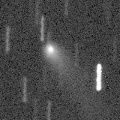
|
It was observed at 14-15 mag from 2014 to 2015. Now it is fading. It has already faded down to 17.3 mag (Aug. 10, D. Buczynski). In the Northern Hemisphere, it keeps observable in excellent condition until winter when the comet will be fainter than 18 mag. It is not observable in the Southern Hemisphere.
Date(TT) R.A. (2000) Decl. Delta r Elong. m1 Best Time(A, h)
Sept. 3 4 46.07 75 47.9 5.986 5.945 82 17.6 4:52 (184,-21)
Sept.10 4 51.85 77 1.9 5.964 5.986 86 17.6 4:42 (183,-22)
|
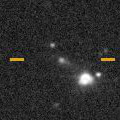
|
It is 16.8 mag now (Aug. 31, Kunihiro Shima). It was expected to brighten up to 16 mag and observable in good condition in autumn. But actually, it is fainter than originally predicted.
Date(TT) R.A. (2000) Decl. Delta r Elong. m1 Best Time(A, h)
Sept. 3 22 59.44 -11 56.8 1.798 2.805 174 17.8 0:11 (180, 67)
Sept.10 22 54.05 -11 59.9 1.787 2.786 171 17.7 23:34 (180, 67)
|
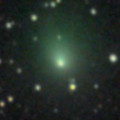
|
It brightened up to 10 mag in 2015 autumn. Now it is fading. It has already faded down to 17.8 mag (Aug. 26, Alexander Baransky). It will be fainter than 18 mag in September.
Date(TT) R.A. (2000) Decl. Delta r Elong. m1 Best Time(A, h)
Sept. 3 3 39.67 13 57.0 2.678 3.092 104 17.7 4:51 (180, 41)
Sept.10 3 40.39 13 48.7 2.621 3.131 111 17.8 4:24 (180, 41)
|
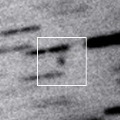
|
Now it is 17.4 mag (July 2, G. Gunn, G. W. Christie). It keeps observable at 17.5 mag in good condition from spring to autumn in the Southern Hemisphere. It is not observable in the Northern Hemisphere.
Date(TT) R.A. (2000) Decl. Delta r Elong. m1 Best Time(A, h)
Sept. 3 17 42.07 -58 8.1 4.635 4.968 103 17.8 19:06 ( 5, 67)
Sept.10 17 46.76 -57 17.6 4.716 4.967 98 17.8 19:11 ( 15, 67)
|

|
It brightened up to 3.7 mag and became a naked eye comet in mid January in 2015 (Jan. 13, Marek Biely). Now it is fading. It has already faded down to 16.7 mag (Aug. 9, Purple Mountain Observatory, XuYi Station). It will be fainter than 18 mag in September.
Date(TT) R.A. (2000) Decl. Delta r Elong. m1 Best Time(A, h)
Sept. 3 17 14.21 17 25.0 6.464 6.607 93 17.9 19:06 (167, 37)
Sept.10 17 14.44 16 29.6 6.612 6.666 88 18.0 19:11 (158, 36)
|

|
Now it is 17.6 mag (Aug. 6, iTelescope SRO Observatory, Auberry). In the Northern Hemisphere, it will be observable at 17 mag in excellent condition in winter. It locates low in the Southern Hemisphere.
Date(TT) R.A. (2000) Decl. Delta r Elong. m1 Best Time(A, h)
Sept. 3 6 21.32 31 3.6 3.684 3.406 66 18.0 4:52 (215, 14)
Sept.10 6 30.27 31 13.4 3.590 3.401 71 17.9 4:42 (213, 15)
|

|
Now it is 18.9 mag (Aug. 28, K. Sarneczky, P. Szekely). In the Northern Hemisphere, it will be observable at 17 mag in excellent condition in winter. It locates somewhat low in the Southern Hemisphere.
Date(TT) R.A. (2000) Decl. Delta r Elong. m1 Best Time(A, h)
Sept. 3 3 46.44 23 13.7 2.476 2.848 101 18.0 4:52 (181, 32)
Sept.10 3 51.53 23 31.9 2.384 2.842 106 17.9 4:35 (180, 31)
|
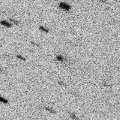
|
Now it is 17.0 mag (Aug. 31, Kunihiro Shima). It is observable at 18 mag in excellent condition in autumn.
Date(TT) R.A. (2000) Decl. Delta r Elong. m1 Best Time(A, h)
Sept. 3 1 42.14 8 37.9 1.810 2.612 133 18.0 2:53 (180, 46)
Sept.10 1 40.88 8 38.6 1.765 2.625 140 17.9 2:25 (180, 46)
|
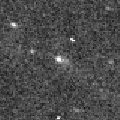
|
First return of a new periodic comet which brightened up to 16.5 mag in 2008. The condition of this apparition is very good. It was expected to brighten up to 15.5 mag in autumn and will be observable in good condition. But actually, it is 17.4 mag (Aug. 31, Kunihiro Shima), fainter than originally expected by 2-3 mag.
Date(TT) R.A. (2000) Decl. Delta r Elong. m1 Best Time(A, h)
Sept. 3 0 13.74 -15 27.1 1.409 2.374 157 18.0 1:25 (180, 70)
Sept.10 0 6.37 -14 49.6 1.378 2.362 163 17.9 0:51 (180, 70)
|
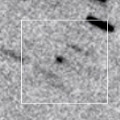
|
Now it is 18.6 mag (Aug. 31, Kunihiro Shima). It is observable at 18 mag in excellent condition in autumn.
Date(TT) R.A. (2000) Decl. Delta r Elong. m1 Best Time(A, h)
Sept. 3 1 14.71 4 8.2 1.709 2.578 141 18.0 2:26 (180, 51)
Sept.10 1 12.47 4 1.3 1.670 2.586 149 17.9 1:56 (180, 51)
|

|
It was observed as bright as 13-14 mag for a long time from 2011 to 2014. Now it is fading. It is observable in excellent condition in the Southern Hemisphere. It locates extremely low in the Northern Hemisphere. No observations have been reported since August, 2015.
Date(TT) R.A. (2000) Decl. Delta r Elong. m1 Best Time(A, h)
Sept. 3 16 55.62 -37 31.0 9.816 9.972 95 17.9 19:06 ( 74, 77)
Sept.10 16 54.87 -37 30.7 9.969 10.006 89 18.0 19:11 ( 75, 71)
|

|
Now it is 17.1 mag (July 9, Kunihiro Shima). It was expected to brighten up to 14 mag from winter to summer. But it is much fainter actually. It will be observable in excellent condition in the Southern Hemisphere. It locates low in the Northern Hemisphere.
Date(TT) R.A. (2000) Decl. Delta r Elong. m1 Best Time(A, h)
Sept. 3 16 42.09 -37 37.1 3.166 3.378 93 19.6 19:06 ( 75, 75)
Sept.10 16 50.00 -37 28.4 3.311 3.432 88 19.8 19:11 ( 76, 70)
|
|
![]()
 C/2014 OE4 ( PanSTARRS )
C/2014 OE4 ( PanSTARRS ) 219P/LINEAR
219P/LINEAR 93P/Lovas 1
93P/Lovas 1 C/2015 VL62 ( Lemmon-Yeung-PanSTARRS )
C/2015 VL62 ( Lemmon-Yeung-PanSTARRS ) C/2014 A4 ( SONEAR )
C/2014 A4 ( SONEAR ) 74P/Smirnova-Chernykh
74P/Smirnova-Chernykh 47P/Ashbrook-Jackson
47P/Ashbrook-Jackson C/2015 V1 ( PanSTARRS )
C/2015 V1 ( PanSTARRS ) C/2015 B2 ( PanSTARRS )
C/2015 B2 ( PanSTARRS ) C/2016 K1 ( LINEAR )
C/2016 K1 ( LINEAR ) C/2012 F3 ( PanSTARRS )
C/2012 F3 ( PanSTARRS ) C/2010 U3 ( Boattini )
C/2010 U3 ( Boattini ) P/2007 T6 ( Catalina )
P/2007 T6 ( Catalina ) 340P/2016 N2 ( Boattini )
340P/2016 N2 ( Boattini ) 343P/2016 P3 ( NEAT-LONEOS )
343P/2016 P3 ( NEAT-LONEOS ) C/2014 N3 ( NEOWISE )
C/2014 N3 ( NEOWISE ) 188P/LINEAR-Mueller
188P/LINEAR-Mueller 22P/Kopff
22P/Kopff C/2015 H2 ( PanSTARRS )
C/2015 H2 ( PanSTARRS ) C/2014 Q2 ( Lovejoy )
C/2014 Q2 ( Lovejoy ) P/2015 TP200 ( LINEAR )
P/2015 TP200 ( LINEAR ) P/2005 S3 ( Read )
P/2005 S3 ( Read ) 341P/2016 N3 ( Gibbs )
341P/2016 N3 ( Gibbs ) 338P/2016 N1 ( McNaught )
338P/2016 N1 ( McNaught ) 208P/McMillan
208P/McMillan C/2010 S1 ( LINEAR )
C/2010 S1 ( LINEAR ) C/2014 Y1 ( PanSTARRS )
C/2014 Y1 ( PanSTARRS )![]()


















































